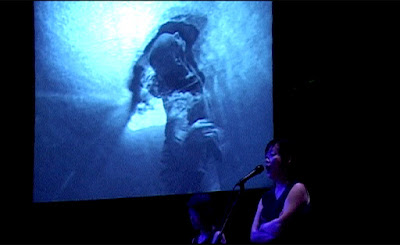The Improlab team plus Ami Yoshide and Sachico M (Japan) finally made two nights of improvised performance at the Studio, Sydney Opera House. The Studio is a tough and unadventurous space, and hard place to find inpiration. Each night we ran two sections of about 40 minutes each. After the first night I was completely drained and after the second I was rushed into a speedy bump out. Our rehearsals were much better than the shows. But the audiences were as expected - half bored out of their minds and the other half totally enthused. Overall I think its the most genuine and rewarding artform anyone could hope to participate in. Realtime Arts Review: http://www.realtimearts.net/article/77/8340
The Improlab team plus Ami Yoshide and Sachico M (Japan) finally made two nights of improvised performance at the Studio, Sydney Opera House. The Studio is a tough and unadventurous space, and hard place to find inpiration. Each night we ran two sections of about 40 minutes each. After the first night I was completely drained and after the second I was rushed into a speedy bump out. Our rehearsals were much better than the shows. But the audiences were as expected - half bored out of their minds and the other half totally enthused. Overall I think its the most genuine and rewarding artform anyone could hope to participate in. Realtime Arts Review: http://www.realtimearts.net/article/77/8340

Comments
I'm not so interested in this because of the artificiality of the impression of realtime image creation. With the live camera as something happens, the camera operator's response is immediate, and sometimes impulsive and often much of the strain of the work is controlling the immensity of the outcome. It is a very sensitive medium to use for live projection, that's why I prefer it to laptops and prerecorded material. There is a visceral response with camera movement, control of focus, exposure and zoom to the immediate sound and physical environment. Another thing I appreciate is perhaps having its roots in Cinema Verite. There is an unpretentiousness to the environment and the situation. I see what is there with each of the cameras and the images begin to feed back off each other, creating a kind of transcendence of the sum of the space. Over the year or so part-time development of this, and the opportunity of working with very experienced improvisors, had a very big effect on me and I'm going to continue working in this way, or adaptations of it whenever possible in other projects.
One of the difficulties worth noting in our performance at the Studio, is because it is a true response to the space, the performance was more difficult than the several other spaces we rehearsed in - (PICA, Rex Cramphorne Studio, The Drill Hall). The Studio I think is a great presentation space but a difficult space to find life and character in. Its resonance is a kind of thick, odius sumptuousness which is hard to overcome! Like trying to taste a nice light white wine while eating supreme pizza. That's a strange analogy.. We are doing the same work down in Melbourne at '45 downstairs' in March. I'm sure that will be an interesting one.